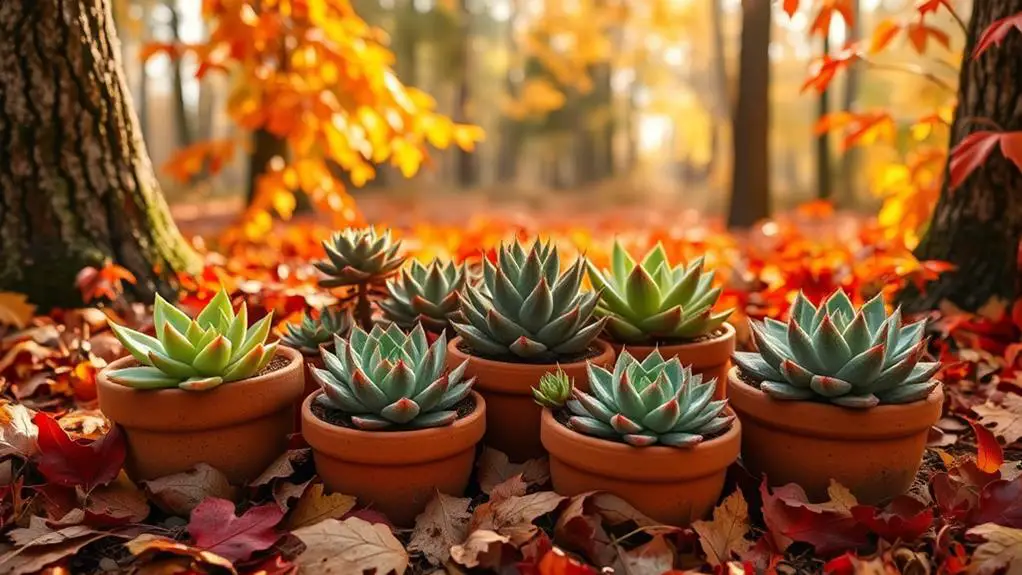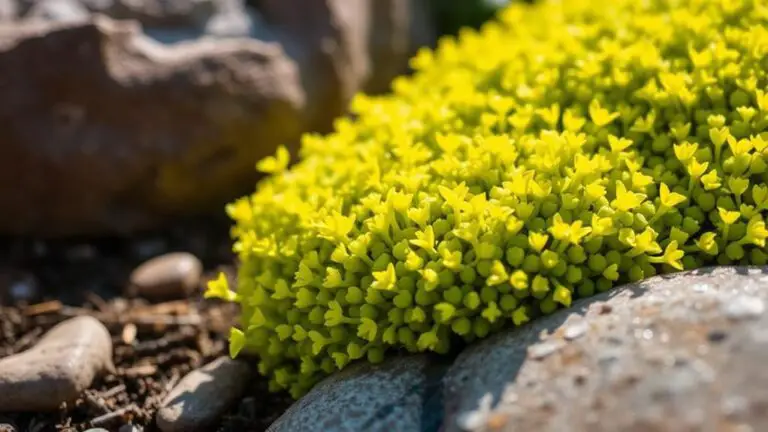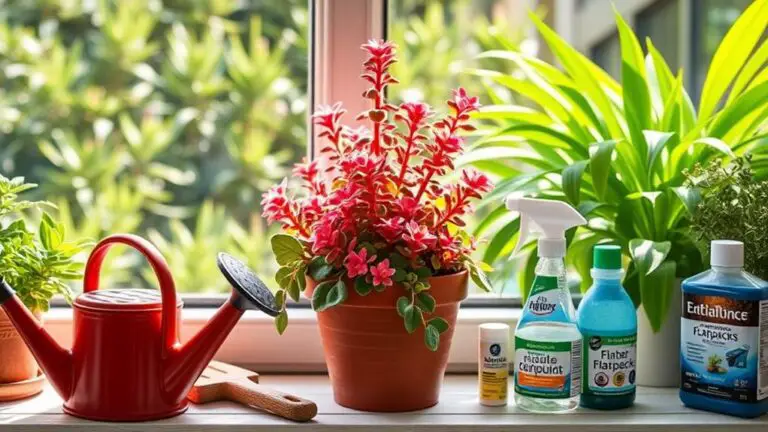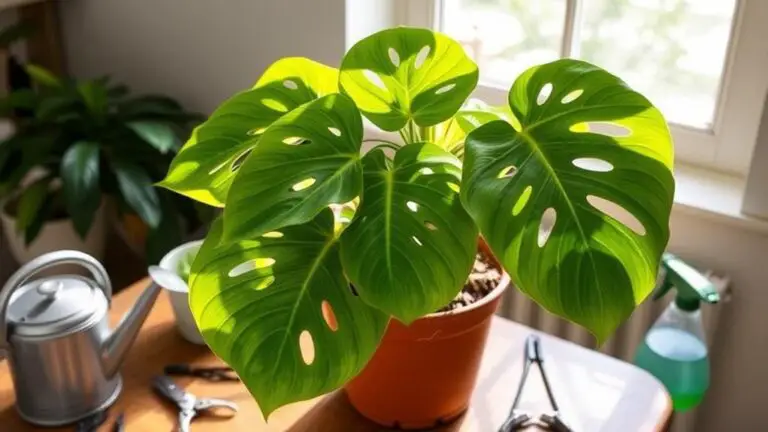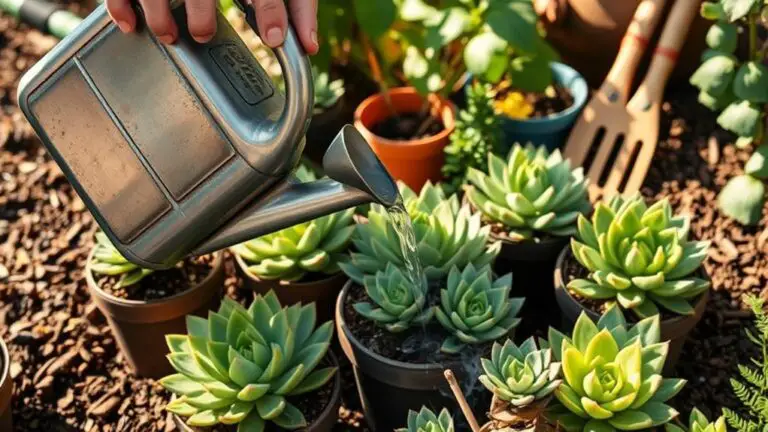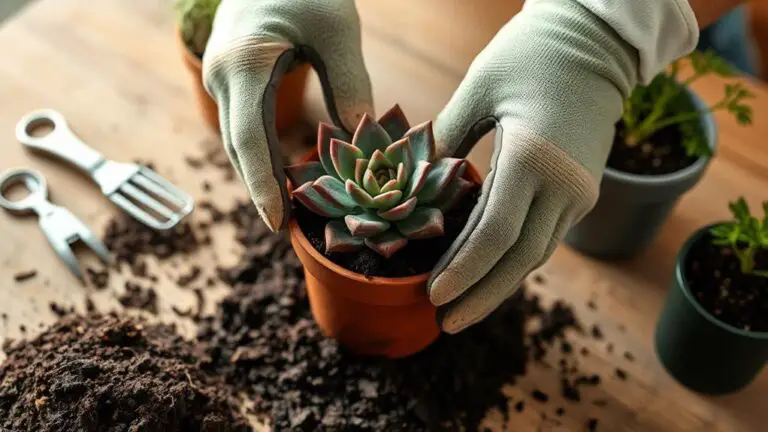7 Essential Tips for Fall Succulent Care
As fall approaches, your succulents need special attention to thrive through the season's changes. You might think succulents are low-maintenance, but they require specific care to handle cooler temperatures and reduced sunlight. Have you considered how temperature drops can affect them, or how to adjust your watering schedule properly? It's also vital to know the right amount of sunlight they need and when to prune or repot them. By understanding these essentials, you'll guarantee your succulents remain healthy and vibrant. Want to discover the key steps to achieving this? Let's explore each tip in detail.
Seasonal Challenges

As the days shorten in fall, your succulents will naturally slow their growth and begin shifting into dormancy to conserve energy. This seasonal change can present a few challenges, but with the right care, your plants will thrive.
Keep an eye on temperature fluctuations; if outdoor temperatures drop below 40°F, bring your soft succulents indoors. This move will protect them from frost damage.
Indoor succulents need a stable temperature range, ideally between 65°F and 75°F. This helps prevent stress and keeps your plants healthy. When moving them inside, make sure the soil remains well-draining to avoid waterlogged soil, which can lead to root rot.
As the fall season progresses, you might notice signs of reduced energy in your succulents, like yellowing leaves or wilting flowers. These are normal and indicate that the plant is conserving resources.
However, watch out for signs of infestation. Fall can bring increased pest activity as critters seek warmth indoors. Early detection and management are essential to keeping your succulents pest-free.
Light Management

Light management is essential for keeping your succulents healthy and vibrant. As daylight hours decrease in fall, make certain your succulents get enough light. They need about six hours of sunlight daily, so reposition them closer to windows.
Bright, indirect light is best; using sheer curtains can filter harsh sunlight while still providing the illumination they need.
To guarantee even light distribution and prevent leggy growth, rotate your succulents weekly. Leggy growth happens when plants stretch toward the light, signaling they need more.
Keep an eye on your succulents for signs of too much direct sunlight, like burnt leaves. If natural light is scarce, supplement with grow lights to keep them thriving.
Creating a microclimate can also help. Grouping your succulents together not only enhances light exposure but also maintains humidity levels, which is beneficial for their overall health.
This simple trick can make a big difference.
Watering Adjustments

With proper light management in place, let's focus on watering adjustments for your succulents. As temperatures cool in the fall, these plants need less frequent watering. A good rule of thumb is to water only when the top inch of soil is dry to the touch. Overwatering can lead to root rot, so it's vital to confirm the soil has completely dried out between watering sessions.
The "soak and dry" method works best. This means you soak the soil thoroughly until water drains from the bottom, then wait for the soil to dry out completely before the next watering.
Here are some key points to keep in mind:
- Verify the soil is dry to the touch before watering.
- Avoid excess moisture to prevent root rot.
- Adjust watering based on each succulent's specific needs.
Monitoring the moisture needs of different succulent species is important. Some may need more or less water, depending on their individual characteristics and conditions.
During fall, adjust your watering routine to match the plant's reduced metabolic activity. Mimic natural drought conditions followed by hydration to keep your succulents healthy and happy.
Nutrient Care

When it comes to nutrient care, stop fertilizing your succulents during the fall.
They don't need extra nutrients because they're entering a slow growth phase and can use what they've stored.
Keep an eye on the soil to make sure it doesn't have too many nutrients, which can harm your plants.
Cease Fall Fertilization
During fall, it's crucial to stop fertilizing your succulents to preserve their internal nutrient balance. When succulents enter their slow growth phase, giving them extra nutrients can cause problems. Over-fertilization can lead to root burn and stress the plants. Instead, it's best to let them use their stored resources effectively.
Refraining from fertilization helps in several ways:
- Root Development: Without extra nutrients, succulents focus on strengthening their root systems.
- Energy Conservation: Plants conserve energy for necessary functions during dormancy.
- Prevent Nutrient Surplus: Avoiding fertilization stops harmful nutrient buildup in the soil.
These benefits guarantee your succulents stay healthy through the cold months. Fertilizing during this time can result in a nutrient surplus, disrupting their natural dormancy.
This surplus can stress the plants and inhibit their ability to rest. By ceasing fall fertilization, you help your succulents prepare for the growing season in spring.
Monitor Soil Nutrients
It's essential to keep an eye on your soil's nutrient levels to guarantee your succulents stay healthy. During the fall months, succulents generally enter a dormancy phase and don't need fertilization. Instead, they use stored nutrients. However, you still need to monitor soil nutrients to prevent any issues.
Start by using a well-draining soil mix. This type of soil helps avoid waterlogging and provides fundamental nutrients without over-fertilizing. Regularly check your plants for signs of nutrient deficiencies. Yellowing leaves or stunted growth might mean your succulents need a nutrient boost.
Fall is also a great time for repotting succulents. Fresh soil can replenish nutrients that were used up during the summer. When repotting, make sure to choose soil rich in organic matter to support your plants through the winter months.
Pruning and Repotting
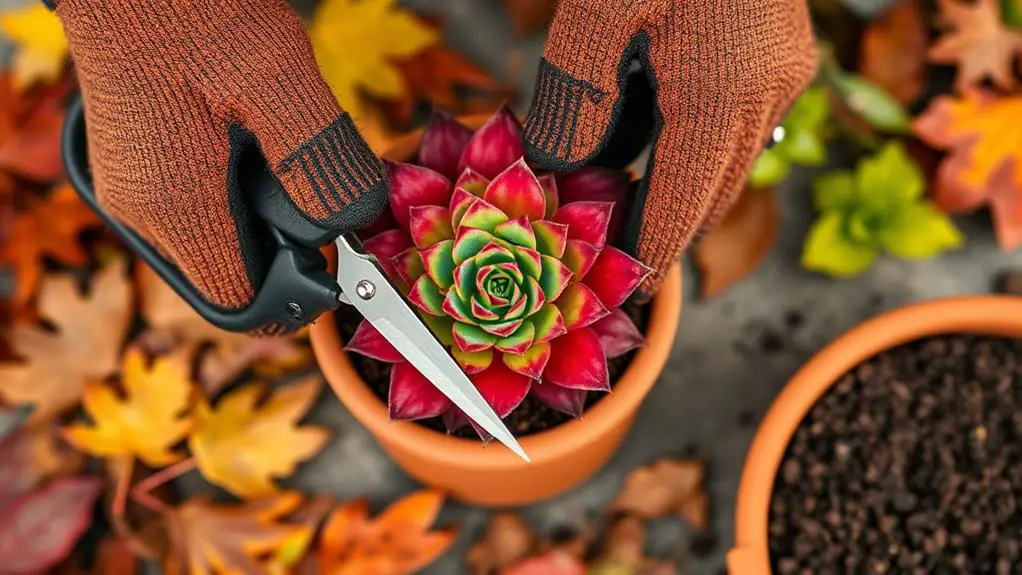
Fall is the perfect time to prune and repot your succulents, ensuring they stay healthy and vibrant.
Remove any dead or yellowing leaves and spent flower stalks to help your plant focus on strong root growth.
When repotting, choose a slightly larger pot with drainage holes and use fresh, well-draining soil to give your succulent the best start.
Timing and Techniques
Pruning and repotting your succulents, particularly in the fall, can greatly enhance their health and appearance. When you prune, you're helping your plant redirect energy towards root development and essential functions. This is especially important as succulents prepare for dormancy.
Remove dead or yellowing leaves and cut back any leggy growth to promote a more compact shape.
For repotting, fall is ideal because your succulents might've depleted their nutrients during summer growth. Fresh, well-draining soil can provide the necessary support they need.
Here are some key techniques to keep in mind:
- Use clean, sharp tools: This helps minimize the risk of pests and diseases.
- Allow soil to dry out completely: After repotting, wait before watering to prevent root rot.
- Focus on spent flowers and leggy growth: This keeps your plant healthy and looking good.
Soil and Pot Selection
When repotting your succulents, choosing the right soil and pot is essential for their health and growth. Start with well-draining soil specifically designed for succulents. A good mix includes 70% potting soil, 20% perlite, and 10% sand. This blend prevents water retention and root rot, keeping your plants happy and healthy.
Next, consider the pots you'll use. Opt for those made of porous materials like terracotta or clay. These materials allow excess moisture to escape, and combined with drainage holes, they prevent your succulents from becoming waterlogged.
Drainage holes are vital—they let water flow out, ensuring your plant's roots stay dry and free from rot.
Fall is a great time for repotting succulents. They may have outgrown their current containers, and fresh soil can replenish nutrients. This also gives the roots more space to develop.
While repotting, check for pests. If you find any, change the soil and clean the pot to avoid spreading pests.
Pruning is another important step. Remove any dead or yellowing leaves to help redirect the plant's energy towards healthy growth. This will make your succulents look more vibrant and encourage stronger root development.
Pest Control
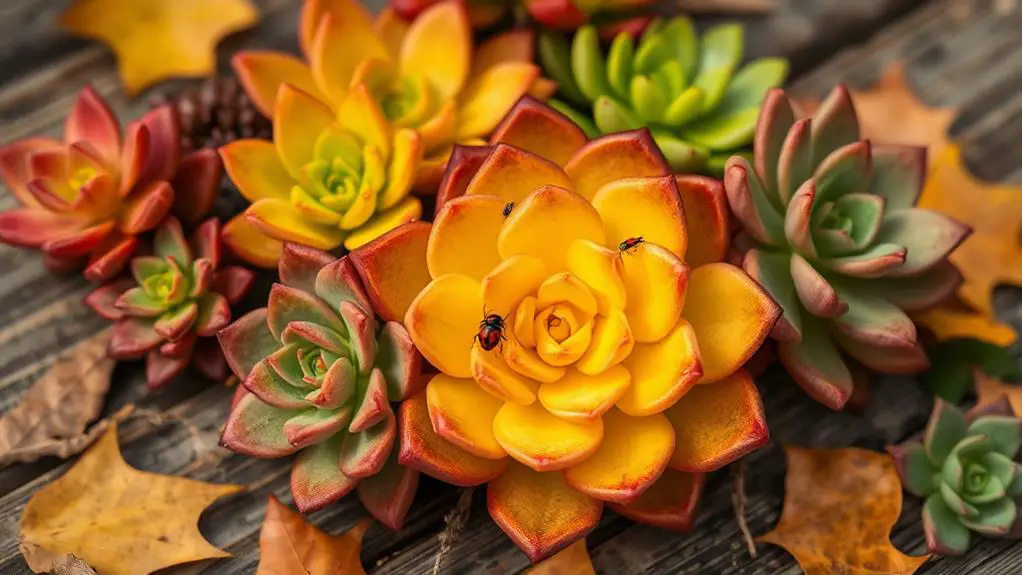
Spotting pests on your succulents can feel like a challenging task, but regular inspections during fall can make all the difference. Increased pest activity, like mealybugs and aphids, is common during this season, so it's essential to inspect your succulents regularly.
Look for signs of pest infestations such as discolored leaves, sticky residue, and unusual markings. Catching these issues early can prevent major damage.
To manage pests effectively, consider using insecticidal soap or neem oil. Both are excellent choices for treating pests, but remember to follow the application instructions carefully for the best results.
If you find any affected plants, isolate them right away to stop the pests from spreading to your healthy succulents.
Maintaining a clean growing environment is also important. Remove debris and dust regularly, as these can attract pests and affect your plants' well-being.
Keeping your succulents free of clutter helps them stay strong and pest-free.
- Inspect your succulents for signs of pest activity.
- Use insecticidal soap or neem oil for treatment.
- Keep the growing environment clean to maintain health.
With these steps, you can keep your succulents thriving through the fall.
Temperature Monitoring
Temperature stability is vital for maintaining healthy succulents. They're sensitive to temperature fluctuations, so keeping an eye on the temperature is essential. To create an ideal environment, maintain indoor temperatures between 65°F and 75°F. This range helps protect your succulents from stress and guarantees they thrive.
Regular temperature monitoring is a must. Use a thermometer to check the temperatures near windows or heating vents, where sudden changes are most likely. Drafts and sudden shifts can cause signs of stress in your succulents, like yellowing leaves or wilting. If you notice these signs, it's a clear indication that the temperature might be off.
As fall temperatures drop, be extra vigilant. If outdoor temperatures fall below 40°F, bring your succulents indoors. Most soft succulents aren't frost-tolerant and exposure to freezing temperatures can damage them.
Moving them inside will protect your succulents from frost and keep them safe.
Frequently Asked Questions
How to Care for Succulents in the Fall?
In the fall, reduce watering, let the topsoil dry, and relocate succulents to brighter spots. Stop fertilizing, check for pests regularly, and prune dead leaves. These practices will help keep your succulents healthy and thriving.
What to Do With Succulents in Autumn?
Bring your succulents indoors when it gets below 40°F to avoid frost damage. Monitor for yellowing leaves, reduce watering, clean windows for light, and check for pests. These steps will keep your succulents healthy in autumn.
How Often Do You Water Succulents in the Fall?
In the fall, you should water your succulents every 2-4 weeks. Always check the top inch of the soil for dryness before watering. Make sure the soil dries completely between waterings to prevent overwatering and root rot.
Do You Cut Back Succulents in the Fall?
Yes, you should cut back succulents in the fall. Doing so helps promote healthier growth by allowing the plant to focus on root development. Prune dead leaves and spent flowers after the first frost using clean, sharp tools.
Conclusion
By following these tips, you'll help your succulents stay healthy and happy through the fall. Keep an eye on temperatures, adjust your watering schedule, and make sure they get enough light. Don't forget to prune and repot as needed, and keep pests in check. With just a bit of care, your succulents will thrive. You've got this, and your plants will thank you for it! Happy gardening!

